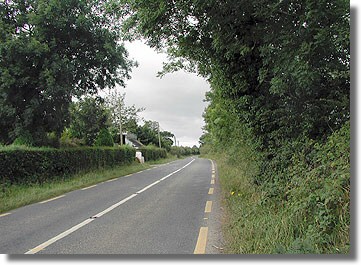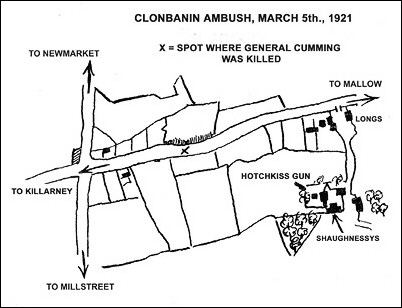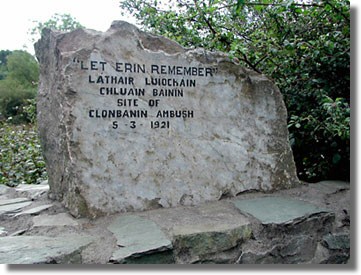|
In early March, 1921 Sean Moylan, Commandant of the Newmarket Column, made
the decision to ambush a British party
of senior officers and their military guard returning from an inspection tour in Kerry. The position he
selected was at Clonbanin, Co. Cork, five miles east of
Rathmore. The position was about six miles from Kanturk, where there was a
strong military post and equidistant to Millstreet, then
garrisoned by a force of Black and Tans and RIC.
At 3
a.m. on the morning of the 3rd. March, Moylan's column moved out for Clonbanin and was in position by 6 a.m. They were
joined by a section of the Kerry No. 2 Brigade Column, under Commandant Tom
McEllistrim, and a detachment from Charleville Battalion Column, under
Commandant Paddy O'Brien. The Newmarket
and Charleville units occupied positions on the northern side of the road. The
Kerry men and a section of the Millstreet Column had positions on the south
side of the road. They had one of the Hotchkiss guns captured at Mallow, manned
by Bill Moylan and Denis Galvin. The remainder of the Millstreet Column
occupied a position covering the roads from Kanturk to deal with expected
reinforcements from that direction. The local companies provided scouting and
protective elements.
Commandant Paddy O'Brien detailed the sections to
their positions and Commandant Moylan arranged for the laying of the half dozen
road mines which the force had. And at 7
a.m. the column was ready for action. Strict
instructions had been given to the section commanders that fire was not to be
opened on any target until a mine was exploded, the explosion being the signal
for attack. This was necessary because of a decision come to by Commandants
Moylan and O'Brien that a very small British force passing through the position
would not be attacked, as long as the hope of intercepting a larger target
existed.

|
|
|
Site
of the Clonbanin ambush looking West.
Fire from
the I.R.A. column's Hotchkiss machine gun was directed
onto the roadway from the left. |
|
|
|
At 10
a.m. the outposts signalled three lorries coming
from the east. This was unexpected, but Moylan and O'Brien
decided to attack. As the leading lorry drove over the mine controlled by
Moylan he pressed the switch but there was no explosion. At the
same moment O'Brien, covering the driver, pressed the trigger of his rifle. The
round failed to go off. Incredibly, the three lorries passed
through the ambush position, a soldier in one of them playing an accordion, the others
singing, blissfully unaware of how close they had been from disaster.
It later transpired
that the reason for the mine failure was that high tension wires were being
used with a low tension battery.
However, it
was still early in the day and the expected convoy from the west would surely make
an appearance. The men settled down again for a long wait. At 2.15
p.m. the patience of the waiting column was
rewarded; a convoy was signalled coming from the west. It consisted of three
lorries, an armoured car and a touring car. The vehicles were spaced, as had
been anticipated, at such intervals as to cover half a mile of road. No attempt
was made now to use the mines. Fire was opened on the leading lorry, the driver
was hit and it was ditched. A burst from the Hotchkiss penetrated the slit in
front of the driver of the armoured car; the driver was wounded and it too was
ditched. The remaining vehicles halted, their occupants dismounting rapidly and
seeking whatever cover was available. A tall man in officer's uniform was seen
to jump from the touring car and run for cover on the north side of the road.
He was shot down before reaching there and was later discovered to be
Brigadier-General Cumming.


The action intensified and developed into a
long duel that did not end until dusk. Shortly after the armoured car
was ditched its heavy machine-gun came into action and continued firing during
the entire course of the fight. The opposing forces were about equal in strength
but the British had the advantage of heavier weapons and a far better
supply of ammunition. The armoured car commanded the road and prevented two
efforts made by the IRA to drive in the flanks of the British position. The
British forces, too, attempted an outflanking manoeuvre but it was defeated by IRA.
fire. The British had the advantage also of a deep ditch and several houses
which gave them cover from the fire of the Kerry and Millstreet units on the
south side of the road.
The I.R.A. had no
means of putting the armoured car out of action and they always had to consider the possibility
of
reinforcements reaching the British. The sound of firing could be heard distinctly at
Kanturk, Newmarket
and Millstreet, and reinforcements from these posts would eventually arrive. General
Cumming's brigade headquarters at Buttevant was only twenty-five miles away,
and the fight had continued for well over two hours. As dusk drew in it
was decided to withdraw, the Kerry and Millstreet units to the west, and the Newmarket
and Charleville units north to Kiskeam. It was learned later that the British
casualties were thirteen killed and fifteen wounded. The columns suffered no
casualties.
|


